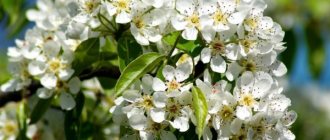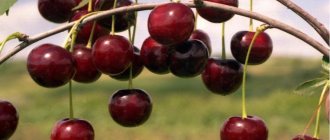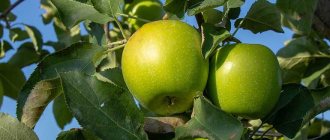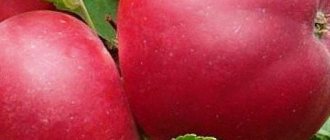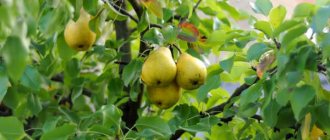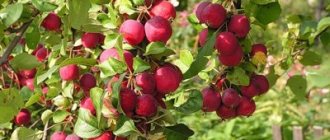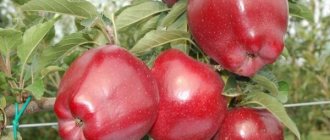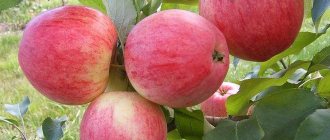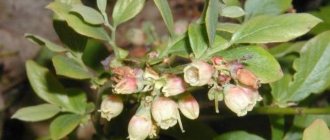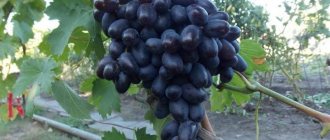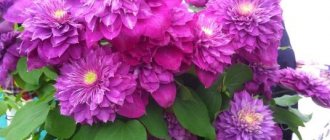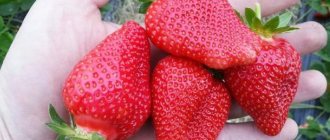One of the ancient early-ripening varieties of folk selection is the Korobovka apple tree, also known as Medunichka or Skorospelka. Produces very sweet small apples that ripen in summer.
This variety is practically not used in cultivated gardening, although, for example, in Poland it is considered one of the oldest varieties of apples, for which it is included in a special list.
In our country, it was no longer zoned due to its excessive small fruit, but it is widely used at fruit stations as a mother form for winter-hardy early-ripening varieties and is valued by breeders for its excellent hereditary traits.
It can be found in ancient abandoned gardens, since the tree is characterized by a long fruiting period (up to 50 years).
Description of the Korobovka apple tree variety
Korobovka has never been an object of industrial cultivation, but has been valued by Russian amateur gardeners for a long time. This variety also has some popularity in Ukraine, the Baltic states, Poland and Belarus.
Features of the variety
The main feature of the Korobovka apple tree is its small, tasty fruits, which have an amazing aroma and taste. It is also worth noting the tree’s solid lifespan, of which it bears fruit for 50 years. For a more detailed description and photo of the apple tree, see below.
Tree morphology
The structure of the tree can be called powerful. The height of Korobovka can reach 5.5 - 6 m; in the first 15 - 20 years of its life, its crown has a pyramidal shape, but over the years it becomes more spreading and acquires a massive paniculate shape. After 25 years, tree growth becomes very slow, although in the first years it can be said that the seedling grows very actively and quickly.
The crown is formed by medium-sized shoots, on which there are small rounded-elongated dense emerald green leaves, slightly curved, with a jagged edge.
Productivity and tasting evaluation of fruits
The Korobovka Apple tree variety belongs to the type of fruit whose yield increases over the years, so, on average, it is 50 - 60 kg, during the period of maximum fruiting it can reach 70 kg.
The fruits are very tasty and have a fresh apple aroma. Small in size - maximum possible weight 50 g, diameter - 4 - 5 cm - they are not inferior in taste to other summer apples.
Round, slightly flattened downward, covered with a thin yellow-green skin with red stripes along the entire perimeter. The pulp is yellowish, loose, juicy - ideal for fresh use and cooking compotes. Sugar content more than 10%.
Winter hardiness and disease resistance
One of the main advantages of the variety is its high adaptation to frost and excellent winter hardiness. This quality is mainly the reason why the variety has not yet been abandoned and is used by breeders.
As for resistance to pathogens, it should be noted that there is an average resistance to scab, but at the same time, the apple tree can be affected by the codling moth, so it is necessary to carry out preventive treatment against this pest, which is capable of destroying most of the crop.
Lifespan of a tree
An apple tree of this variety can be considered a long-liver, moreover, for most of its long life it is capable of producing small, tasty fruits.
Diseases and harmful insects
It should be noted for the sake of fairness that Korobovka rarely gets sick and is almost never attacked by parasites; this uniqueness is not characteristic of many apple varieties. Insects and fungi do not like to live on Korobovka, which allows it to live long and successfully. But, nevertheless, during periods of prolonged rains, signs of scab may appear, and during the fruiting period, the codling moth becomes active. There are effective methods of combating these scourges.
- Such preparations as “Siroko”, “Atom”, “Fufanol” can be used to get rid of hatched caterpillars before they bite into the fruit. This organophosphorus group of fungicides can work very effectively on apple trees and preserve the harvest.
- For the mass destruction of parasites, biological agents are used: “Fitoverm”, “Bitoxibacillin”. They are more gentle drugs, but they also act very powerfully.
- Gardeners successfully use cyhalothrins: Gdadiator, Vantex, as well as pyrethroids: Ivanhoe, Arrivo and others.
- In the summer, the most effective drugs will be: “Insegar”, “Dimilin” and “Herold”.
Treatment with chemicals should be done in calm weather, following the instructions and all possible precautions: gloves, special clothing, mask.
As for scab, the main thing here is to notice its spread in time. The disease can appear on any part of the tree: fruits, petioles, leaves or ovary. Spots on gray or brown foliage should immediately alert the gardener and force him to take the necessary measures to eliminate the disease. The fungal disease spreads unusually quickly and does not spare young branches that have weak resistance. You can fight scab with chemicals, copper sulfate, whitewashing, and removing infected parts.
Smoking in a dream - why do you have a dream about smoking, interpretation of a dream about cigarettes according to dream books
Reviews:
- I remember the taste of these apples from childhood, sweet and very aromatic. To this day, wild animals can still be found in the abandoned garden of the collective farm. This year I want to try to plant Medunichka on my plot, I hope it will be possible to revive such a good variety - in my memory there are no tastier and sweeter apples, and what kind of compote are they?
- I don’t understand why there is a need to bring back some old outdated varieties when there are now modern, more sustainable and tasty ones. Look around people, what is there to revive? Small, scanty koloboks that in a couple of weeks will cease to have any taste? It’s not a fact that it will work out, but how much space will this colossus take up in the garden? No, I think we need to live for today and plant what does not remember the times of Lenin on an armored car.
- We still have this apple tree in our old dacha - a really tasty summer one. In general, apples appear on it every year, but they can be removed in abundance only once every 4 years. We are trying to rejuvenate it to extend its life, but now we are thinking of planting a seedling from it so as not to lose it completely, because the taste and smell of these summer apples cannot be compared with anything!
Tree and fruit
This tree has never been grown on an industrial scale, but despite this, it is very common and known throughout Belarus, the Baltic states, Ukraine and Poland.
According to its structural characteristics, the tree belongs to a powerful subspecies; its height reaches 6 m. During the first 25 years, the crown has a pyramidal shape. In subsequent years of its life, the tree is shrouded in a spreading crown.
The leaves are green, with an emerald tint, and round in shape, dense in structure. Their edges are jagged, which is their distinctive feature.
Each tree produces a lot of fruits. You can harvest up to 70 kg of apples from one crop.
The pulp of the fruit is yellowish. There is practically no sourness in it. You can compare the taste of these fruits with honey. They are characterized by increased juiciness. Can be consumed even when not fully ripe.
Features of planting and caring for an apple tree
Dates and methods of planting
Planting a seedling can be done in the fall (September) so that it can take root before the onset of frost. Or in the spring, in April, when the threat of return frosts has passed.
For planting, it is best to choose sunny areas with normal groundwater. Before planting, prepare a hole for the seedling with a depth of 50–60 cm, remove the top layer of soil, mix it with humus. A peg and a seedling are placed in the middle of the hole, carefully covered with the soil mixture made earlier and spilled with water.
You can make a small roll of soil along the outer perimeter of the hole to retain moisture.
Planting an apple tree in autumn
Agricultural technology for apple trees Korobovka
Agricultural technology includes several main activities:
- Watering;
- Feeding;
- Loosening;
- Removing weeds.
Watering is carried out in the root zone from spring to autumn, starting from the budding stage, adjusted for weather conditions. The amount of watering depends on the age of the tree; for an adult apple tree - 15 liters of water once a week.
Watering the apple tree
Organic fertilizers are applied in the fall before winter, slightly deepening them, mineral fertilizers - starting in spring: nitrogen-containing fertilizers on thawed-frozen soil, phosphorus-potassium fertilizers - according to the scheme, starting from the budding period with a frequency of three weeks before the start of ripening. If there is a need, you can also fertilize with microelements by spraying on the green mass.
Important! For preventive control of diseases and pests, it is advisable to introduce periodic spraying into agricultural technology: fufanon, Inta-Vir, copper sulfate. To increase the vitality of the tree and its immunity, drugs such as Zircon and Epin will be indispensable.
Caring for the tree trunk includes timely removal of weeds and loosening of the top layer of soil to improve moisture and air exchange. Loosening is carried out the next day after watering.
Pruning and crown formation
Pruning is carried out in autumn and spring. In the fall, it is necessary to remove damaged and weak shoots, which can become a hotbed for the spread of fungal and bacterial diseases in winter.
In the spring, formative pruning is carried out. You need to start approximately 3–4 years after planting the apple tree. Remove old, outdated branches, shoots that were damaged during wintering by snow drifts, and branches growing inside the crown.
Crown trimming
Pollinator varieties
Korobovka is a self-fertile apple tree, therefore, in order to obtain a full harvest, it is necessary to be in the vicinity of a pollinator variety, which include Cinnamon Striped, Papirovka, White Naliv, Kitayka Saninskaya.
Important! If you do not plant a pollinator variety, the number of ovaries formed will sharply decrease, which, accordingly, will lead to reduced apple tree productivity.
Growing
“Korobovka” is unpretentious to soil and weather conditions, so it can be grown almost anywhere, but pollinators must grow nearby. Despite its unpretentiousness, the tree still needs constant care. It is better to plant 1-2 year old seedlings in the spring, before the buds swell. Three-year-old trees, on the contrary, are recommended to be planted in the fall after the leaves have fallen from the trees. The soil needs to be prepared in advance, per 1 m2 you need to add 15 kg of humus, 70 grams of superphosphate and 40 grams of sulfate, and then dig it well.
The planting hole should be at least 80 centimeters deep and approximately 120 centimeters in diameter. You should not plant trees close to each other; the distance between them should be 4-5 meters. Apple trees of the following varieties should grow nearby: White filling, Papirovka or Kitayka Saninskaya. Before planting, the roots are soaked in water for two hours and then dipped in a mixture of “Kornevin” and wood ash.
Experienced gardeners recommend mulching the soil with peat, this will help retain moisture in the soil. Seedlings need regular watering and loosening of the soil; young trees require less moisture, and older trees more. In autumn, moisture-recharging watering is mandatory; this procedure significantly increases resistance to frost.
You can fertilize the soil once every 3 years; weeds should be removed as they grow. Dried branches are trimmed and a crown is formed in early spring. Also, after a long winter, it is advisable to treat trees against pests; bioinsecticides are perfect for this. But the procedure should be carried out in dry, windless weather, since the drug is effective for 3 days. If necessary, spraying can be repeated after 14 days.
Before winter, tree trunks are whitened or limed; this procedure protects against frost and prevents pests from penetrating under the bark. Wounds and cracks on the tree can be treated with garden brew or vitriol. Some gardeners wrap the trunk with rags for the winter in order to protect the plants from the cold.
Features of ripening and fruiting
A young boll apple tree bears fruit annually (see photo and description of the variety above), increasing the size of the harvest every year, but after 20 years the yield is periodic (every four years) and along with the increase in the number of apples collected from one tree, their size changes - from over the years they become smaller in size.
Fruiting begins 7–8 years after planting and is of an increasing nature. The fruits begin to ripen in mid-July, en masse - from the end of July, they are able to hold tightly to the tree and do not fall off. Apple trees are not stored for long, only 30 days, however, it is best not to do this, because storing them spoils the taste of the fruit.
Their purpose is to eat fresh, cook compotes and jams, and use them in making wine. Despite their inability to keep well, apples are characterized by good transportability
Important! If your crop crumbles, this is a clear sign of codling moth infestation, which should be a signal for immediate measures to combat this pest.
History of selection
The Korobovka apple variety, which has gained immense popularity due to its taste, was bred by S. I. Isaev in the process of working together with M. P. Maksimova.
It was obtained by crossing the Cinnamon Striped with Wesley.
Korobovka is known as one of the very old early summer apple varieties, widely used in folk breeding.
The fruits were first scientifically described in 1855.
They presumably got their name because in those days they were sold in markets not by piece or by weight, but in boxes, like various berries, due to their too small size.
On the territory of Russia, as well as some other countries of Eastern Europe and Western Asia, this variety of apples has long been excluded from zoning.
This decision was explained by the small size of the fruit.
Despite this, many breeders value Korobovka for its ability to transmit all hereditary characteristics to its offspring.
Thanks to such qualities, trees can be used as a mother form in the creation of other early, tasty and frost-resistant varieties of apples.
In Poland, Korobovka was included in the collection collected in the Warsaw Biological Reserve. It is also valued in Estonia - it is included in the list of ancient apple tree species.
Features of growing the variety in the regions
Moscow region
In the Moscow region, Korobovka can be grown without any special agrotechnical measures, because climatic conditions and soil resources fully meet the requirements of this variety.
It is necessary to monitor the physical and chemical composition of the soil and apply organic and mineral fertilizers on time.
Ural and Siberia
The winter hardiness of the Korobovka apple tree allows it to be cultivated in the Urals and Siberia. You can try to grow it on a columnar scion, the only problem is that in harsh winters the tops of the plants may freeze, but by waiting for a problem, you can usually prevent its occurrence.
Leningrad region
The Leningrad region, its climate and soil resources, make it possible to grow Korobovka apple trees, however, high humidity can cause the development of bacterial and fungal diseases, the resistance to which is low in this variety.
In light of the possibility of such a problem, one should immediately take preventive measures to combat possible pathogens and carefully monitor the condition of the plants.
Korobovka is a variety with excellent taste characteristics, a honey flavor and a classic apple aroma - an excellent apple for enjoying fresh fruits in mid-summer, making compotes or wines. If you want to please yourself and your loved ones with these delicious babies, just surround the trees with care and attention. For such an unpretentious variety, this will be enough!
Landing rules
The fruits have a pleasant taste
Successful cultivation of an apple tree of the Korobovka variety depends on the quality of planting material, the time of planting, the correct location and soil.
Deadlines:
- in a harsh climate zone - in the spring, at the end of March or at the beginning of April, when the threat of return frosts has passed;
- in the south and in the middle zone - in early autumn, 1.5 months before the onset of persistent cold weather (from mid to late September).
Place and soil
Choose an area where there is no wind and the sun shines all day. This way the tree will fully grow and bear fruit. You can plant it in the south, southwest or southeast side of the garden.
You should not plant it in acidic soil, where the apple tree will develop poorly and produce a meager, unpalatable fruit harvest. If the acidity value is above 6 units, 400 g of calcite, chalk or slaked lime are added per 1 m².
You can plant a tree on loam or sandy loam. If the soil is heavy, it is necessary to loosen it using perlite or vermiculite - 20 kg per 1 m². After adding all the components, the planting area is dug up and leveled.
Seedling preparation
You can purchase planting material of this variety at a specialized nursery or gardening store.
Choose a seedling 50-60 cm high, 2-3 years old - it has a well-developed root system and crown.
Typically, trees are sold in an earthen coma or in containers so that the roots do not dry out before planting and successfully survive the procedure of transplanting into open ground.
You can determine the freshness and quality of an apple tree by the state of the crown - the shoots are flexible, covered with fresh, juicy leaves of rich green color. There are no signs of disease or mechanical injury on all organs.
Landing technique
For full development and high-quality fruiting, seedlings require space - about 4.5 m.
The depth and width of the hole depends on the root system. Approximate parameters are 70x60 cm. A peg is driven closer to the wall for support.
Stages:
- The bottom of the pit is covered with drainage - pebbles, screenings or crushed stone.
- Then half lay the mixture of dug soil with humus and peat - a bucket of each component.
- Add 150 g of wood ash, 50 g of potassium sulfate and superphosphate to the soil mixture.
- To prevent the roots from getting burned, sprinkle with a thin layer of garden soil.
- The seedling is installed so that the root collar remains on the surface. Straighten the roots, fill in all the voids, compact them.
- After this, the tree needs to be watered - at least 2 buckets, mulched with peat or compost and tied to a support.
Landing
Korobovka seedlings are placed in the ground at the age of 1-2 years in early spring, when the buds are not swollen. Trees that are up to 4 years old are best planted in the autumn, after the leaves have fallen.
When planning planting in the fall, it is necessary to prepare the soil in the spring. To do this, it is enough to add fertilizers per 1 square meter while digging the soil. m:
- humus – 15 kg;
- sulfate – 40 g;
- superphosphate – 70 g.
It is necessary to dig up the soil no deeper than the bayonet of a shovel. When digging a hole to place a seedling in it, it is worth considering its size. The optimal depth of the hole is no more than 1 m, and the width is 1.3 m. If you plan to plant a garden of Korobovka apples, then the distance between the rows should not be less than 6 m.
The future fruit tree must be planted in a hole, in the middle of which a wooden stake is inserted.
